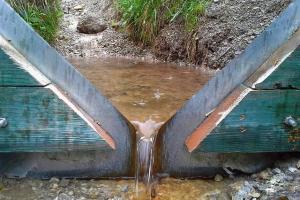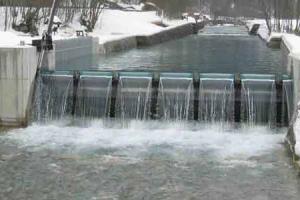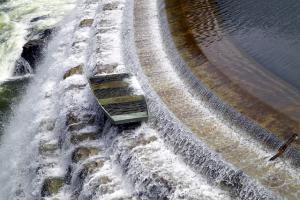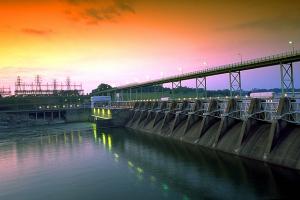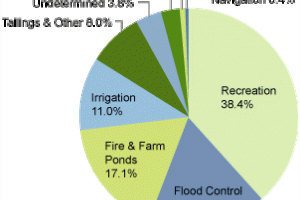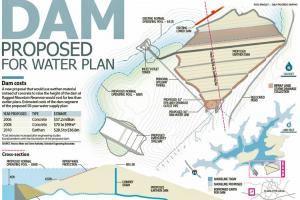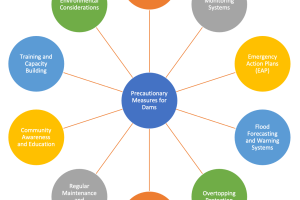Purposes of Dams - Importance, Functions and Applications
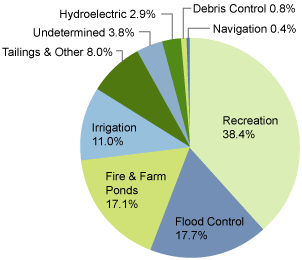
Dam is a barrier built across a river to hold back river water for safe retention and storage of water or control the water flow. Dams allow to divert the river flow into a pipeline, a canal or channel. Dams results in substantially raising water levels in the river over a large area, thus create a storage space. Purposes of dams are described as below:
Purposes of Dams
Dams and reservoirs are built to raise water level for storage and safe retention of large quantity of water. Water is subsequently raised to achieve various purposes. Dams may be constructed to meet one or more purposes as:
- Irrigation
- Hydropower development (Tarbela Dam, Mangla Dam)
- Domestic, municipal, industrial water supply (Hub dam, Simly dam in Islamabad)
- Storage of Water
- Flood control
- Recreation (picnic, camping, fishing, swimming, kayaking, white water rafting).
- Fish and wildlife protection and development, and improvement of river ecology.
- River water quality / pollution control and management.
- Stream flow regulation for various purposes.
- Navigation
Most dams are multi-purpose, serving more than one purpose. Mostly these additional purposes are achieved as byproduct outcome, e.g., hydropower, recreation, etc. For multipurpose dams, the storage is allocated and prioritized for different purposes and cost allocation.

Dams for the purpose of Irrigation
According to a study of World Commission on Dams, half of the world's large dams were built exclusively or primarily for irrigation and an estimated 30-40% of the 271 million hectares of irrigated lands worldwide rely on dams. Dams are estimated to contribute 12-16% of world food production. About 1 billion people depend on food produced by reservoir related irrigation. There is no alternative of how this food could have been produced by other means. (WCD Study, November 2000)
A majority of dams built in the world are multipurpose in nature, but irrigation is the largest user of the waters withdrawn. Dams enable harnessing of large water resources, to meet needs of fast growing societies round the world: food, fodder, fish production (aquaculture), drinking water, clothing, sanitation, energy, industry, wildlife and others. A major portion of water stored behind dams in the world is withdrawn for irrigation which mostly comprises consumptive use, that is, evapotranspiration (ET) needs of irrigated crops and plantations.
Dams for the purpose of Hydropower
When a dam is built, it stops the flow of the river and causes the water level to rise. The higher water level then allows for the harvesting the energy of the through the falling of that water. The reservoir the dam creates literally acts as stored energy. Water then flows from high to low through turbines within the dam. The water spins the turbines which are connected to a generator to turn the rotar which then creates the electric power.
Dams provide clean, pollution free energy, but they can also harm the environment. Species that use rivers to spawn are often hurt by dams.
Hydropower plants has several advantages. Once a dam has been built and the equipment installed, the energy source i.e. flowing water, is free. It's a clean fuel source renewed by snow and rainfall. Hydropower plants can supply large amounts of electricity, and they are relatively easy to adjust for demand by controlling the flow of water through the turbines.
Dams for the purpose of Water Supply
Purposes of dams for domestic water supply includes everyday activities such as water for drinking, cooking, bathing, washing, and lawn and garden watering.
Dams for Storage of Water
Not all the water stored behind dams is withdrawn for use. A top depth varying from 1 to 2 meters depending on local climate, is annually lost to atmosphere due to evaporation. At the bottom, some depth serves as a dead storage for accommodating sediment brought in by inflow. Dead storage size depends upon the catchment area characteristics but similar to evaporation losses, tends to be proportionately more in case of a smaller dam. Storages provide insurance against uncertainty due to climatic variability, can help reduce variability in season’ slow flows in rivers and basically save societies from economic upheavals and losses due to flood and drought.
Dams for Flood Control
It is an internationally accepted practice that the water level of a reservoir should be kept below a certain level before the onset of the monsoon season. This is so that when the monsoon rains come, there is space to store the excess rainwater and also so that water can be released in a regulated manner, thus preventing floods downstream when there is heavy inflow to the dams. It is important that at least 30% of the storage capacity of dams be kept free before the monsoon.
In addition to helping farmers, dams help prevent the loss of life and property caused by flooding. Purposes of dams for flood control impound floodwaters and then either release them under control to the river below the dam or store or divert the water for other uses. For centuries, people have built dams to help control devastating floods.
Dams, reservoirs, flood levees, embankments, and river training works constitute structural measures for better flood management. In the field of Integrated Flood Management (IFM), dams and reservoirs can be considered a viable and effective alternative, especially when there are extensive settlements on the floodplains which make it impossible to restrict land uses or implement other non-structural measures. Dams and reservoirs, in general, constitute an effective structural measure, since they are able to store large flow volumes, modify flood routing and significantly reduce peak flows.
Dams for Recreation
Dams provide prime recreational facilities throughout the world. Boating, skiing, camping, picnic areas, and boat launch facilities are all supported by dams.
Navigation purposes of dams
Dams and locks provide for a stable system of inland river transportation throughout the heartland of the Nation.

Multipurpose Dams
Storage that serves the need for irrigation, domestic and industrial water supply, power generation and recreation can be more efficient and cost-effective than storage serving single purposes. Multipurpose dams also have some disadvantages. Different uses of water have different and sometimes conflicting requirements in terms of storage, use and releases. For example, demands for energy during peak times may require water to be released from dams when irrigators require water to be stored for later use. Ensuring reasonable allocation between water-using sectors is critical and requires careful management to deliver the full range of economic, social and environmental uses of water.



